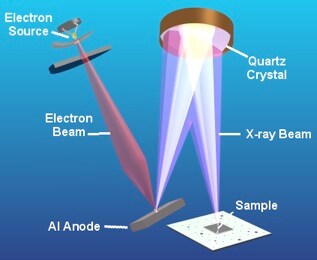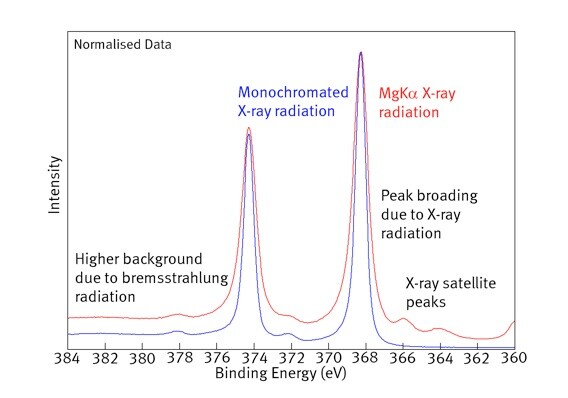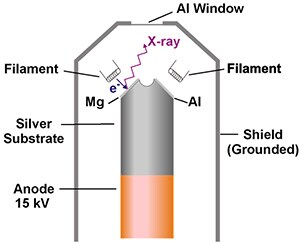Search

Materials Science
XPS X-Ray Sources
X-ray sources for X-ray photoelectron spectroscopy.
XPS X-Ray Sources
In XPS instruments, X-rays are generated by bombarding a metallic anode with high-energy electrons. The energy of the emitted X-rays depends on the anode material and beam intensity depends on the electron current striking the anode and its energy.
Early XPS instruments were fitted with non-monochromatic X-ray sources because the sensitivity of the early instruments was low. Sensitivity and monochromator design have improved, and most XPS instruments include monochromators as standard equipment and non-monochromatic sources are optional.

X-ray monochromator
With a monochromated X-ray source, X-rays strike the parallel crystal planes at an angle θ and are reflected at the same angle. The distance travelled by the X-rays depends on the crystal plane at which they are reflected. If the distance between two crystal planes each reflecting X-rays is d, then the path length difference is 2dsinθ. If this is equal to an integral number of wavelengths, then the X-rays interfere constructively. This effect produces the Bragg equation:
nλ = 2dsinθ
Where n = the diffraction order, l = X-ray wavelength, d = the crystal lattice spacing and q = the angle of diffraction (the Bragg angle).
The physical properties of quartz combined with its lattice spacing and availability as a single crystal, makes it the only material used for commercial X-ray monochromators in combination with Al K-alpha radiation. The quartz crystal is usually bent when it is used as an XPS monochromator.
For the monochromators fitted to Thermo Scientific XPS Instruments, the radius of curvature is different in each direction (i.e., it is toroidally bent), which allows the X-rays to be focused and monochromated.
Electrons are emitted from a bright source, such as LaB6, and focused onto a water-cooled, aluminum anode. Some of the X-rays emitted from the anode are intercepted by the crystal and a monochromated beam of X-rays is focused onto the sample. The size of the X-ray spot at the sample is equal to the size of the electron beam spot on the anode. Therefore the analysis area can be controlled by controlling the electron beam spot size.
X-rays produced in a twin-anode source have a wide X-ray line width, satellite X-ray peaks and a continuum of background radiation. All of these factors affect the quality of the XPS spectrum.



Twin X-ray anode sources
The non-monochromatic X-ray sources found on older instrumentation are fitted with two anodes, usually aluminum and magnesium, which enables selection of the most appropriate anode for the specific analysis.
To generate X-rays, one of the two thoria-coated iridium filaments is heated and emits electrons, which are accelerated onto the anode. The impact of the electrons with the anode causes X-ray emission. X-ray generation requires the dissipation of a large amount of power by the anode, and the anode must therefore be water cooled.
The X-ray source is covered by housing with a thin aluminum window through which the X-rays can pass. The housing is necessary to shield the sample area from the fields generated in the source region and to prevent contamination from the filament.

To maximize sensitivity, the twin anode source is mounted on a linear motion drive so it can be moved close to the sample, maximizing the X-ray flux at the surface. The X-ray source is carefully designed so when anode 1 is in use there is minimal radiation produced by anode 2, minimizing cross contamination. For Thermo Scientific XPS Instruments, cross contamination is less than 0.35%.
The standard X-ray source is supplied with aluminum and magnesium anodes. Other materials are available that produce various X-ray energies and line widths.
Energy and line widths of available anode materials. | |||
| Anode | Radiation | Photon Energy (eV) | Line Width (eV) |
|
|
|
|
|
|
|
|
|
|
|
|
|
|
|
|
|
|
|
|
|
|
|
|


